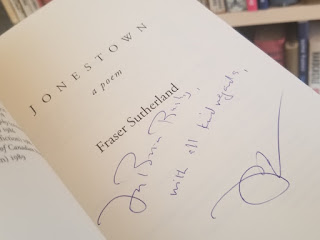Edward Maxwell [pseud Ted Allan]
London: Heinemann, 1957
116 pages
It has the appearance of a publisher's note, but I suspect it was written by Allan. Either way, the fiction has already begun.
 |
 |
| The Avro Canada CF-105 Arrow |
Ted Allan was living in the UK when Quest for Pajaro was written, but I don't imagine for a minute that he wasn't following news from home about the real life Arrow, the most advanced jet aircraft of its day.
If anything, Maxwell's Arrow is even more remarkable in that it is both jet and rocket propelled. On the evening before the first test flight, which he himself is to pilot, our hero invites mathematician friend Alan Ryerman to discuss the project over dinner. A good amount of gobbledygook follows, much of it speculation as to what might happen if the Arrow cracks the "thermal barrier." Ryerman raises the intriguing possibility that his host might simply disappear. This speculation has to do with the speed Maxwell expects to achieve, combined with the speed of the Earth's rotation, the speed of our planet as it circles the sun, the speed of our solar system in the Milky Way, the speed of the galaxy itself, and... well, you get the idea.
Maxwell regains consciousness in a one-room hut belonging to a Basque goat-herd and his wife. Their only child, an exquisitely beautiful daughter named Angelita, nurses our hero back to health. Just shy of twenty-one, at birth she suffered a brain injury which has rendered her mute.
Maxwell accepts, sending a letter to Ryerman detailing his location. Days pass, during which our bedridden hero and Angelika become increasingly close. Eventually, Maxwell's letter is returned marked with "the careless script of officialdom" that the recipient is deceased. The cancellation date reads "19 Mayo, 1977."
It's only then that our hero realizes he's somehow flown into the future. The Arrow took off on the morning of 15 May 1956, months before the exquisite Angelika was even born!
Bruce Petty's jacket illustration, itself exquisite, is more appropriate to a romance novel than a work of science fiction. But then, Quest for Pajaro is more a love story than a tale about a man and his plane. It's Maxwell love for Angelita – come now, you can't pretend you didn't see that coming – that drives the second half of the book. There's really something for everyone, fans of travel adventure included.
Much as I liked Quest for Pajaro, by the end I couldn't help but think it was better suited to the screen than the page. And so, it came as no surprise to discover that it had once been optioned. Thirteen days after the launch of "satellite moon" Sputnik, Queen of Hollywood gossip Louella Parsons reported:
 |
| The Calgary Herald, 17 October 1957 |
I wonder whether Ted Allan's papers, held at Simon Fraser University and Library and Archives Canada, contain a script. If so, I wouldn't be surprised if it pre-dates the novel.
The fiction that Maxwell is a real person is given a bit of a twist on the dust jacket's front flap:
 |
| The Gazette (Montreal) 27 September 1975 |
Was Lies My Father Told Me the high-point of Ted Allan's career? He was nominated for a Best Original Screenplay Oscar, while the film itself received a Golden Globe for Best Foreign Film. I have no argument with those who instead point to Allan's script for the John Cassevetes film Love Streams, winner of the 1984 Golden Bear.
How is it Love Streams is so forgotten?
Ten Allan was an interesting man and an accomplished writer. One correspondent suggests that Allan's life would make for a riveting biography. Sadly, the days in which the flush publishers would be interested in such a project are long past.
Still, I hold out hope that Ted Allan will better recognized by people twenty-one years in the future than he is today.
Coincidence: The Arrow was rolled out to the public on 4 October 1957 (below), the very same day Sputnik was launched.
 |
| Pray for a Brave Heart Helen MacInnes London: Collins, 1955 |











































